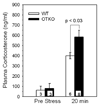Corticosterone release in oxytocin gene deletion mice following exposure to psychogenic versus non-psychogenic stress
- PMID: 18625285
- PMCID: PMC2613443
- DOI: 10.1016/j.neulet.2008.07.004
Corticosterone release in oxytocin gene deletion mice following exposure to psychogenic versus non-psychogenic stress
Abstract
Both anxiety-related behavior [J.A. Amico, R.C. Mantella, R.R. Vollmer, X. Li, Anxiety and stress responses in female oxytocin deficient mice, J. Neuroendocrinol. 16 (2004) 1-6; R.C. Mantella, R.R. Vollmer, X. Li, J.A. Amico, Female oxytocin-deficient mice display enhanced anxiety-related behavior, Endocrinology 144 (2003) 2291-2296] and the release of corticosterone following a psychogenic stress such as exposure to platform shaker was greater in female [J.A. Amico, R.C. Mantella, R.R. Vollmer, X. Li, Anxiety and stress responses in female oxytocin deficient mice, J. Neuroendocrinol. 16 (2004) 1-6; R.C. Mantella, R.R. Vollmer, L. Rinaman, X. Li, J.A. Amico, Enhanced corticosterone concentrations and attenuated Fos expression in the medial amygdala of female oxytocin knockout mice exposed to psychogenic stress, Am. J. Physiol. Regul. Integr. Comp. Physiol. 287 (2004) R1494-R1504], but not male [R.C. Mantella, R.R. Vollmer, J.A. Amico, Corticosterone release is heightened in food or water deprived oxytocin deficient male mice, Brain Res. 1058 (2005) 56-61], oxytocin gene deletion (OTKO) mice compared to wild type (WT) cohorts. In the present study we exposed OTKO and WT female mice to another psychogenic stress, inserting a rectal probe to record body temperature followed by brief confinement in a metabolic cage, and measured plasma corticosterone following the stress. OTKO mice released more corticosterone than WT mice (P<0.03) following exposure to this stress. In contrast, if OTKO and WT female and male mice were administered insulin-induced hypoglycemia, an acute physical stress, corticosterone release was not different between genotypes. The absence of central OT signaling pathways in female mice heightens the neuroendocrine (e.g., corticosterone) response to psychogenic stress, but not to the physical stress of insulin-induced hypoglycemia.
Figures


References
-
- Alheid GF, de Olmos JS, Beltramino CA. Amygdala and extended amygdala. In: Paxinos G, editor. The Rat Nervous System. 2nd edition. New York: Academic Press; 1995. pp. 495–578.
-
- Amico JA, Morris M, Vollmer RR. Mice deficient in oxytocin manifest increased saline consumption following overnight fluid deprivation. Am J Physiol Regul Integr Comp Physiol. 2001;281:R1368–R1373. - PubMed
-
- Amico JA, Mantella RC, Vollmer RR, Li X. Anxiety and stress responses in female oxytocin deficient mice. J Neuroendocrinol. 2004;16:1–6. - PubMed
-
- Amico JA JA, Miedlar JA, Cai HM, Vollmer RR. Oxytocin knockout mice: a model for studying stress-related and ingestive behaviors. In: Landgraf R, Neumann ID, editors. Vasopressin and Oxytocin: From Gene to Behavior. Progress in Brain Research. Vol. 170. Amsterdam: Elsevier; 2008. pp. 53–64. - PubMed
Publication types
MeSH terms
Substances
Grants and funding
LinkOut - more resources
Full Text Sources
Medical
Molecular Biology Databases
Miscellaneous

